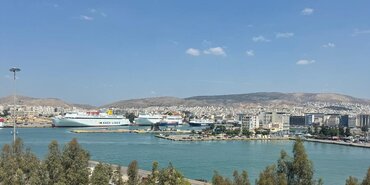Charting the cause of grounding
By Trond Eilertsen and Gaute Gjelsten of Wikborg Rein, Norway www.wr.no/no/
DESPITE continuing advances in navigational, cartographic and hydrographic technology, the potential still exists for major shipping casualties resulting from groundings and strandings. One such case, recently before the courts in Norway, involved the bulk carrier Rocknes which, in January 2004, grounded and capsized after hitting an unmarked shoal at Vatlestraumen, south of Bergen. The case raised serious issues about the standard of duty of care to be applied in relation to State liability for incidents in the public services sector, and the potential exposure to liability faced by, among others, coastal administrations and chart authorities.
The Rocknes sustained severe damage and capsized within minutes, leading to the tragic death of eighteen seamen and causing a serious oil spill. Five years after the incident, the shipowner and its underwriters filed a lawsuit against the Norwegian Government for compensation in respect of losses incurred.
The shoal on which the Rocknes grounded was discovered by the Norwegian Chart Authority during the course of a hydrographic survey in 1995, but the Norwegian State failed to report the shoal in the Norwegian Notices to Mariners, with the result that navigators and pilots were unaware of its existence.
The shipowner and underwriters argued that the State was negligent in failing to give notice of the shoal when it was found in 1995, and started proceedings for reimbursement of vessel repair costs and other losses amounting to approximately NKr 500m-600m ($83m-$100m).
The case was heard by the court in Norway over a period of six weeks. The claimants' principal argument was that the State had been negligent in not reporting the shoal on which the Rocknes had grounded. They further argued that, had the shoal been reported, the navigator and pilot would have been aware of the danger that the shoal represented and the incident would have been avoided.
The State counter-argued that all applicable routines and international rules had been followed, and that the reason the shoal was not reported was that (i) the shoal was close to the shore; (ii) the shoal was located inside the red sector; and (iii) the charts contained no information indicating that the depth at the place of the grounding should be more than ten metres. Further, the State maintained that the navigation of the Rocknes prior to the grounding was negligent and had contributed to the grounding.
The overriding legal question at issue was the standard of ‘duty of care’ to be applied in a case involving the liability of the State in the public services sector. The claim for damages was based on Section 2.1 of the Norwegian Tort Act No 25 of June 13, 1969, according to which the State is liable if (i) someone within the public services sector may be blamed for a negligent or wilful act or omission; (ii) the act or omission infringes upon the claimants' individual rights (as opposed to general public interests); and (iii) the act or omission has caused (or contributed to) the incident.
Under the Tort Act, it is sufficient to show a breach of the duty to take care, irrespective of the individual who has committed the breach. The State is also liable for cumulative failures, whereby the sum of several failures may be characterised as negligent.
Pursuant to the preparatory work on the Tort Act, a moderate standard of ‘duty of care’ applied for the Chart Authority and the Coastal Administration. Whereas older jurisprudence and legal theory concurs with this view, recent legal theory deems that a higher standard of ‘duty of care’ must be applied. The critical question in Rocknes was whether the State could be blamed for individual or organisational negligent acts and/or omissions within the Coastal Administration and/or the Chart Authority which caused or at least contributed to the incident.
Two important precedents deal specifically with the marine public service sectors; the Norwegian Supreme Court decision in Tirranna and the Swedish Supreme Court decision in Tsesis.
In the grounding and subsequent total loss of the Tirranna in Finnsnesrenna, Norway, in January, 1966, a floating light buoy had not been illuminated because the person in charge had failed to change the gas container in good time. The shipowner claimed damages from the State, but the Supreme Court dismissed the claim. The Supreme Court held that the State was not liable even though the light buoy went out due to human failure, because failure as such did not constitute a "substantial and unexpected deviation" from the nautical safety level the authorities aimed to provide.
The facts in Tsesis, meanwhile, were very similar to Rocknes. The Tsesis grounded in October, 1977 in the Stockholm archipelago, on a shoal that had been discovered in connection with a hydrographic survey in 1969, but which was not marked on the sea chart or with a buoy, because the hydrographer had failed to inform the local pilot and the Coastal Administration about it. The Swedish Supreme Court concluded that the State was vicariously liable for the hydrographer's failure to report the shoal. His misjudgment as to the importance of the shoal, and his failure to sufficiently report it, was a negligent act particularly related to the hydrographic survey's relevance for safety at sea.
The judgment of the first instance court in Rocknes was delivered on May 29, 2009. The State was held liable for negligently omitting to report the shoal on which the Rocknes grounded. But, due to the fact that the court held that there was contributory negligence on the claimants' side, and since the court held that the Rocknes would not have capsized had it been properly loaded and the cargo trimmed, the damages were reduced to a minimum.
The Norwegian Authorities filed an appeal within two days of the judgment being handed down. The shipowner and its underwriters filed a separate appeal on July 3, 2009, and the Norwegian Authorities were given a deadline of September 21, 2009, by which to reply. The next step is likely to be a one-day opening before the appeal court in September/October 2009, to agree on further preparations and timing for the appeal court hearing. It is likely that the main hearing will be held in late 2010.
- Date
- 01/03/2010





